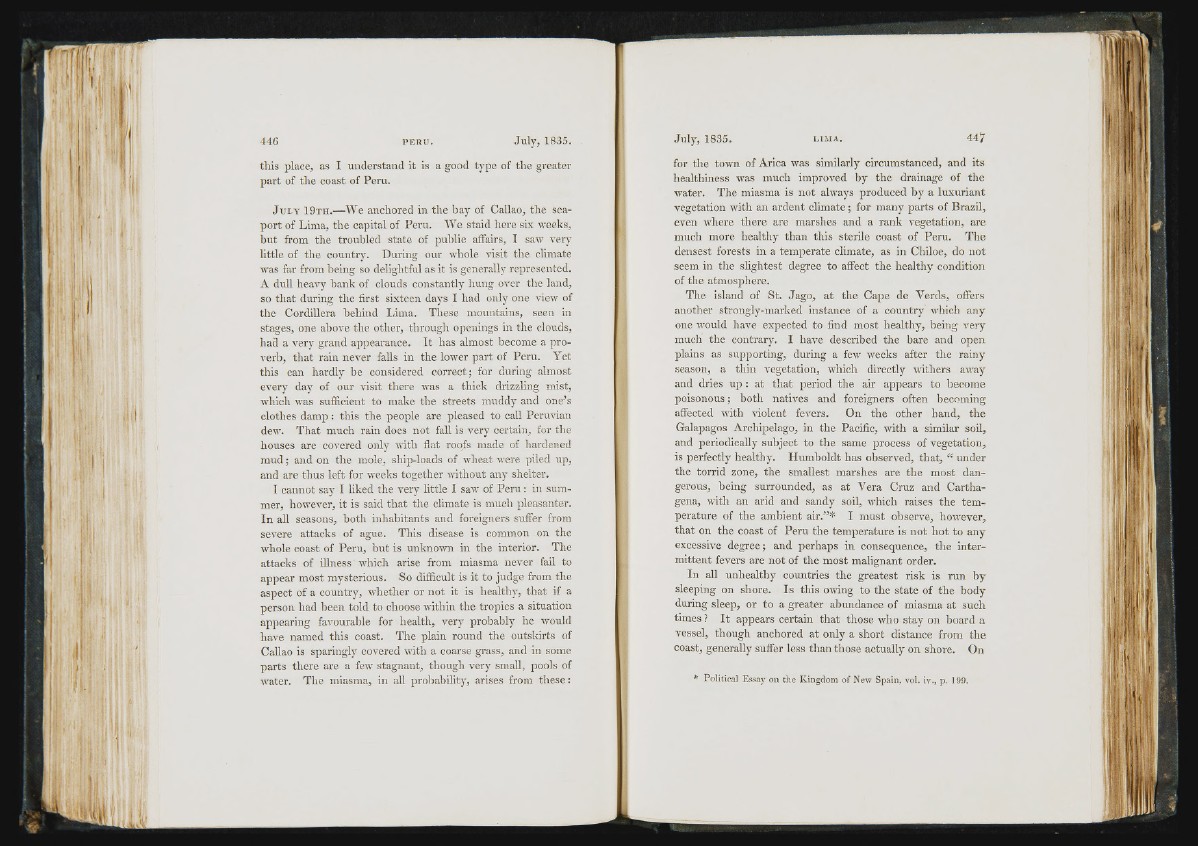
\; ''!'I! !■ '■Ï this place, as I understand it is a good type of the greater
part of the coast of Peru.
J u l y 1 9 t h .—We anchored in the bay of Callao, the seaport
of Lima, the capital of Peru. We staid here six weeks,
but from the troubled state of public affairs, I saw very
little of the country. During our whole visit the climate
was far from being so delightful as it is generally represented.
A dull heavy bank of clouds constantly hung over the land,
so that during the first sixteen days I had oidy one view of
the Cordillera behind I.ima. These mountains, seen in
stages, one above the other, through openings in the clouds,
had a very grand appearance. It has almost become a proverb,
that rain never falls in the lower part of Peru. Yet
this can hardly be considered correct; for during almost
every day of our visit there was a thick drizzling mist,
whioh was sufficient to make the streets muddy and one’s
clothes damp: this the people are pleased to call Peruvian
dew. That much rain does not fall is very certain, for the
houses are covered only v ith flat roofs made of hardened
mud; and on the mole, ship-loads of wheat were piled up,
and are thus left for weeks together without any shelter.
I cannot say I liked the very little I saw of Peru: in summer,
however, it is said that the climate is much pleasanter.
In all seasons, both inhabitants and foreigners suffer from
severe attacks of ague. This disease is common on the
whole coast of Peru, but is unknown in the interior. The
attacks of illness which arise from miasma never fail to
appear most mysterious. So difficult is it to judge from the
aspect of a country, whether or not it is healthy, that if a
person had been told to choose within the tropics a situation
appearing favourable for health, very probably he would
have named this coast. The plain round the outskirts of
Callao is sparingly covered with a coarse grass, and in some
parts there are a few stagnant, though very small, pools of
water. The miasma, in all probability, arises from the se :
for the town of Arica was similarly circumstanced, and its
healthiness was much improved by the drainage of the
water. The miasma is not always produced by a luxuriant
vegetation with an ardent climate ; for many parts of Brazil,
even where there are marshes and a rank vegetation, are
much more healthy than this sterile coast of Peru. The
densest forests in a temperate climate, as in Chiloe, do not
seem in the slightest degree to affect the healthy condition
of the atmosphere.
The island of St. Jago, at the Cape de Verds, offers
another strongly-marked instance of a country which any
one would have expected to find most healthy, being very
much the contrary. I have described the bare and open
plains as supporting, during a few weeks after the rainy
season, a thin vegetation, which directly withers away
and dries up : at that period the air appears to become
poisonous ; both natives and foreigners often becoming
affected with violent fevers. On the other hand, the
Galapagos Archipelago, in the Pacific, with a similar soil,
and periodically subject to the same process of vegetation,
is perfectly health)'. Humboldt has observed, that, “ under
the torrid zone, the smallest marshes are the most dangerous,
being surrounded, as at Vera Cruz and Cartha-
gena, with an arid and sandy soil, which raises the temperature
of the ambient air.” * I must observe, however,
that on the coast of Peru the temperature is not hot to any
excessive degree; and perhaps in consequence, the intermittent
fevers are not of the most malignant order.
In all unhealthy countries the greatest risk is run by
sleeping on shore. Is this owing to the state of the body
during sleep, or to a greater abundance of miasma at such
rimes ? It appears certain that those who stay on board a
vessel, though anchored at only a short distance from the
coast, generally suffer less than those actually on shore. On
* P o litic a l E ssay on th e K in g d om o f New S p a in , vo l. iv ., p . 199.
i tl
(«
m I